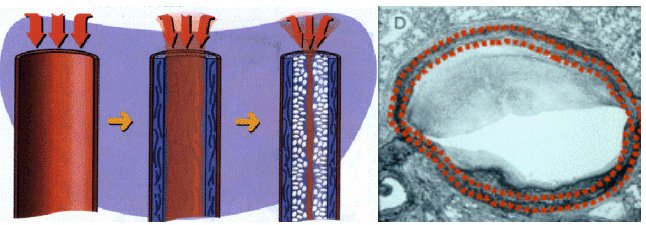Causes and classification
Pulmonary hypertension is classified into five groups:
- Pulmonary arterial hypertension (PAH), caused by the proliferation of smooth muscle cells in the small pulmonary arteries (figure), including:
1.1. Idiopathic PAH (formerly called primary pulmonary hypertension, PPH): without a known cause.
1.2. Hereditary PAH.
1.3. PAH related to drug use and weight-loss pills.
1.4. PAH associated with:
1.4.1. a connective tissue disease.
1.4.2. HIV infection.
1.4.3. portal hypertension with or without liver cirrhosis.
1.4.4. a congenital heart condition.
1.4.5. schistosomiasis. - PH associated with left heart disease.
- PH associated with lung disease and chronic hypoxia (oxygen deficiency).
- Chronic thromboembolic pulmonary hypertension (CTEPH), caused by chronic pulmonary embolisms, where blood clots obstruct the large pulmonary arteries.
- PH with unclear and/or multifactorial mechanisms.

PAH is a rare disease: in Belgium, approximately 500 patients are affected, with an estimated 60 new cases each year. PAH is a serious condition that significantly limits patients’ daily lives. Without treatment, life expectancy is greatly reduced. All age groups are affected, including children and the elderly.
The incidence of CTEPH is estimated to be between 5 and 17 cases per million inhabitants.

Symptoms
- Shortness of breath during exertion.
- Fatigue.
- Chest pain.
- Dizziness, sometimes fainting.
- Palpitations.
- Coughing.
- Hoarseness.
- Swollen feet.
- Enlarged liver and bloated abdomen.
- Swollen veins in the neck.
Contact
Centre for pulmonary hypertension
-
Secretariat: +32 16 34 68 33 - weekdays from 09:00 to 12:00
-
Specialised nurses: +32 16 34 64 97 - weekdays from 09:00 to 11:00
-
Study coordinator: +32 16 34 68 42
-
Hospitalisatie 16: +32 16 34 65 00 - from 16:30
Last edit:
31 january 2025